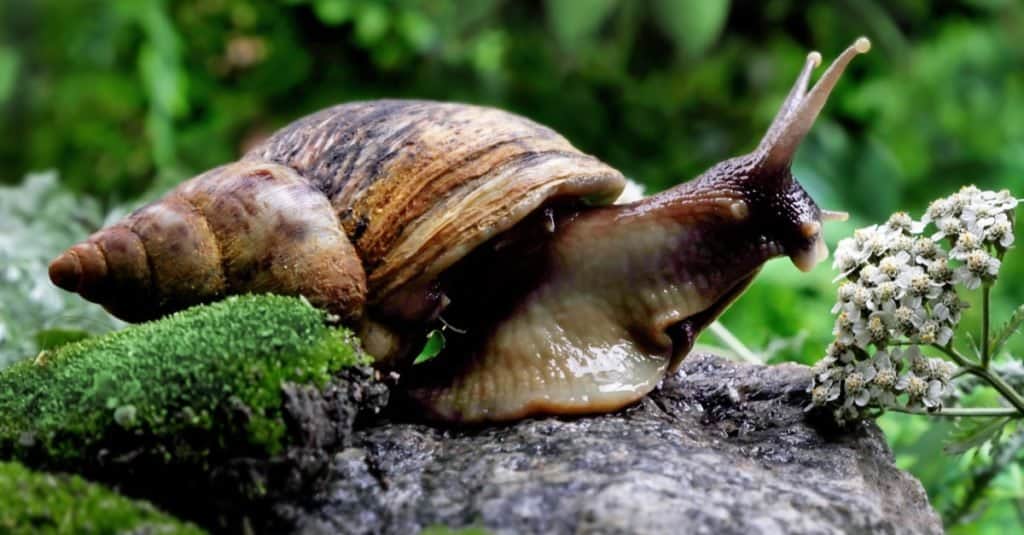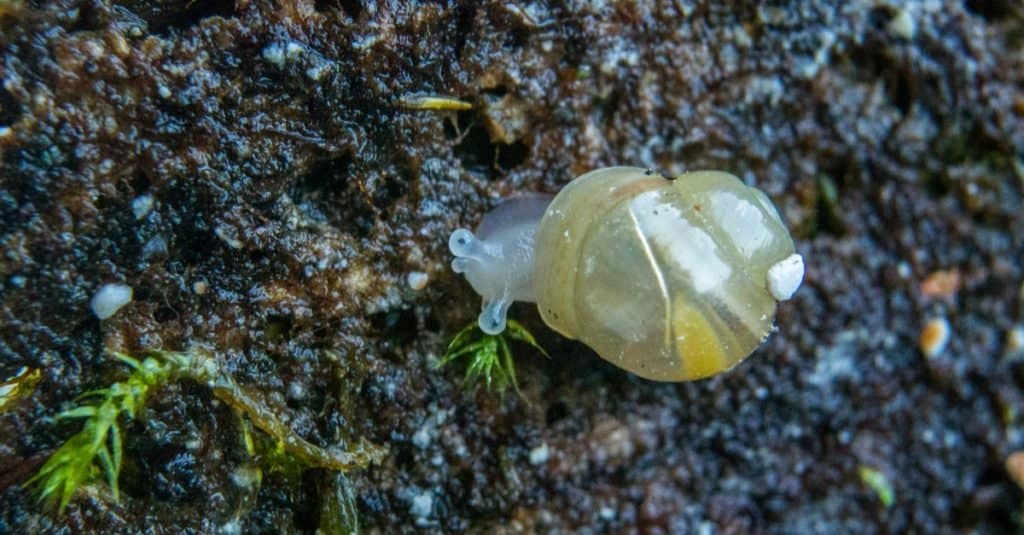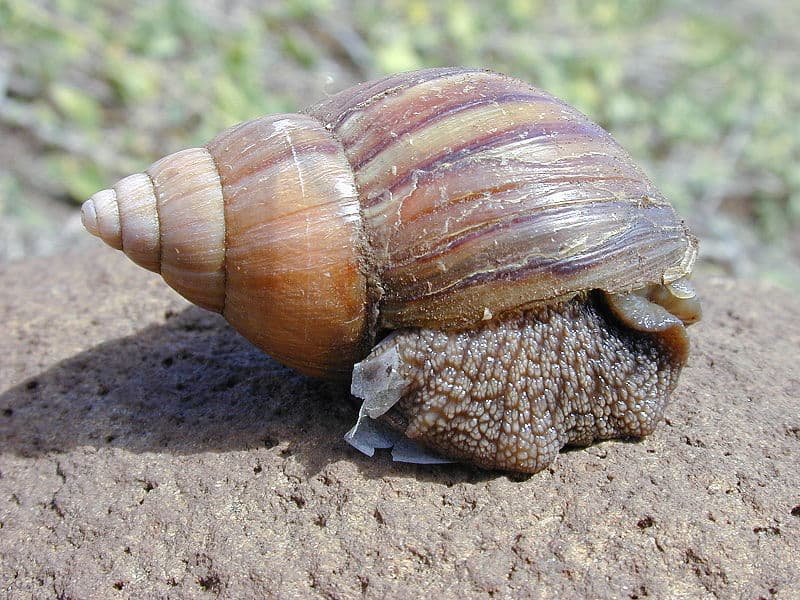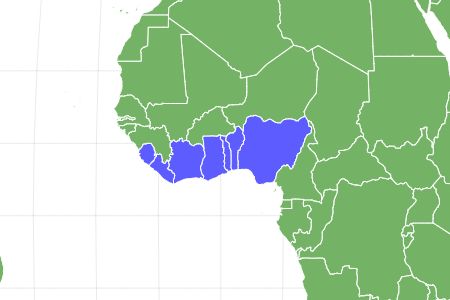Giant African Land Snail
Achatina fulica
The biggest snail species on land!
Advertisement
Giant African Land Snail Scientific Classification
- Kingdom
- Animalia
- Phylum
- Mollusca
- Class
- Gastropoda
- Order
- Achatinoidea
- Family
- Achatinidae
- Genus
- Achatina
- Scientific Name
- Achatina fulica
Read our Complete Guide to Classification of Animals.
Giant African Land Snail Conservation Status
Giant African Land Snail Facts
- Average Litter Size
- 200
- Lifestyle
- Solitary
- Favorite Food
- Leaves
- Type
- Mollusc
- Slogan
- The biggest snail species on land!
View all of the Giant African Land Snail images!
The Giant African Land Snail is a big, tough, well-traveled snail.

As its name suggests, the Giant African Land Snail is one of the largest snails in the world. Although it is native to East Africa, it has been introduced in many other places. It is a destructive, agricultural pest considered one of the top 100 invasive species in the world. The Giant African Land Snail evolved in tropical climes, but it has learned to thrive in more temperate areas and may even hibernate, or estivate, during the colder or drier months.
3 Incredible Facts
- One of the problems with an infestation of these snails is that they often carry parasites that cause infections or serious diseases such as meningitis or schistosomiasis.
- In the 1960s, the state of Florida spent a million dollars and 10 years to eradicate this snail, but it was reintroduced in 2011 and 2021, so new eradication programs are working to prevent crop loss.
- The Giant African Land Snail never stops growing. Although its growth rate slows as it ages, it will keep growing until it dies.
Scientific Name

The Giant African Land Snail is the result of perhaps 350 million years of evolution.
©Tina Khruslova/Shutterstock.com
Although there are a few animals called the Giant African Land Snail, this article deals with the species Lissachatina fulica (formerly Achatina fulica). The snail belongs to the Achatinidae family. It is also known by a number of synonyms and has five subspecies. The species name is derived from the Greek word for “agate,” and may describe the attractive pattern on the animal’s shell. Fulica is Latin for a type of water fowl.
The ancestry of land snails, like the Giant African Land Snail, goes back 350-260 million years ago when plant life first appeared on land. Adaptations followed to enable mobility and eating.
Appearance
The first thing a person notices about a fully grown Giant African Land Snail is its size. The animal is almost 3 inches high, can grow to nearly 8 inches long, and can easily fill the palm of a grown man’s hand. It weighs a little over an ounce.
The largest of these snails was 14.7 inches long. That’s still not as large as its cousin, Achatina achatina. The largest of these snails, named Gee Geronimo, had a body that was 15.5 inches long, and a shell that was 10.75 inches long and weighed 2 pounds.
In Lissachatina fulica, the shell is higher than it is wide and the whorls turn either clockwise or counter-clockwise depending on the individual, although most snails have clockwise turning shells. By the time the snail is grown, the shell can have between seven and nine whorls, or spirals. Most shells are shades of brown with attractive stripes and streaks. The color depends largely on the animal’s diet and environment. The shell of the Giant African Land Snail is famously tough and rich in heavy metals. Like all land snails, L. fulica’s muscular “foot” allows it to move. Its head has two pairs of fleshy tentacles.
Behavior

©Mark Brandon/Shutterstock.com
The Giant African Land Snail is solitary and seeks out other snails only when it’s time to breed. Like most other land snails, it lays down a protective trail of slime as it moves over rough terrain. The shell is also used for protection. The brownish shades of L. fulica‘s shell help camouflage it as well.
The snail is active at night and sleeps during the day after it buries itself in soil. During the night, the snail leaves its shelter and seeks food. It doesn’t hear as humans do, but it has other senses to alert it about its environment. Its eyes are found on the upper pair of its tentacles and the lower pair possess olfactory organs. The snail relies mainly on these two senses to help it navigate the world.
If a group of these snails get together, they are called a walk, a trail, an escargatoire or a rout.
Habitat
This giant snail originated in what are now the countries of Tanzania, Mozambique, Somalia, and Kenya and is currently found in much of the world including Asia, the Caribbean, and North and South America. Habitats where L. fulica flourishes include the coast, the forests, around rivers, shrublands and wetlands, and even cities. Since the snail doesn’t migrate, this means it was introduced into these other areas, either accidentally or deliberately. Some people collected them as pets, but the snail escaped; sometimes they were brought over on cargo ships or hitched a ride on vehicles; sometimes they were introduced as a food source. Because one gravid snail can lay hundreds of eggs at a time, it is easy for the snail population to explode in countries where the snail is not native.
Diet

The Giant African Land Snail will eat almost anything plant-based, plus pebbles, sand, and bones.
©NinaM/Shutterstock.com
The snail is an herbivore and will eat an amazing variety of plant-based materials. Biologists have counted at least 500 types of plants that the snail will eat. It does not care if the plant is living or dead. This snail will even eat paper and concrete. To fortify its shell, it will eat sources of calcium such as pebbles, sand, and bones. It will eat the dead bodies of small animals. When food is really scarce, Giant African Land Snails will eat their own eggs or resort to cannibalism.
The diet of the snail changes as it ages. Young snails are partial to algae and plants and flowers that are soft or even rotting, although a snail caretaker should not feed a snail decaying food as it may still sicken them. Older snails prefer fresh, living vegetation, including fruits and vegetables such as cucumbers, bananas, and lettuce. The snail is able to eat such a varied diet because it has a radula, which resembles a long tongue full of serrated teeth. This organ grates the animal’s food and makes it easier to digest.
Predators and Threats
The Giant African Land Snail has a great many predators. These include rats, foxes, wild boars, hermit crabs, and other snails such as the cannibal snail. Fire ants and flatworms also attack and devour L. fulica, especially when it’s young. Despite this, the snail is not endangered.
Reproduction, Babies, and Lifespan

This baby Giant African Land Snail starts out as a male but will become a hermaphrodite as it matures.
©Svitlyk/Shutterstock.com
One of the most fascinating things about the Giant African Land Snail is that it is a hermaphrodite, which means it has both male and female reproductive organs. The snail starts life as a male, then becomes a hermaphrodite as it matures.
Since the snail can’t fertilize itself, it must seek a mate. L. fulica is particular when it comes to a mate, and it chooses according to age and size. If the potential mate is the same size, chances are higher that both snails will become gravid. If one is larger, the larger snail acts as the female.
The snails begin by tenderly courting, then exchanging sperm, which can be stored in the snail’s body for as long as two years. Mating has been known to last as long as two hours, and it happens at night. The snail lays its eggs between 8 and 20 days later in nests, or in the soil, or among rocks.
A snail that is laying eggs for the first time will probably lay only 100 or so. Later, it can lay as many as 500 eggs at a time. The older it gets, the more eggs it lays, and in hospitable climates, it can lay eggs every eight to twelve weeks.
About 90 percent of the eggs will hatch in approximately two weeks, if the temperature goes above 59 degrees Fahrenheit. The baby snails or hatchlings are miniatures of their parents and do not undergo metamorphosis like sea snails. Neither parent provides care.
L. fulica is sexually mature when it is six months old. It has a lifespan of about 3 to 5 years, although some have lived as long as 10 years. Whether the animal is in captivity or the wild does not seem to make much difference in its lifespan. Although predators keep the numbers of these snails in check in their native areas, introduced snails die of old age, or because of eradication programs, or because the climate is inhospitable even for them.
Population

The large population of the Giant African Land Snail is not a good thing when it brings disease and causes damage to crops.
Given how quickly L. fulica reaches reproductive age, its fecundity, and its ability to quickly adapt to different habitats, there are probably millions of them worldwide. In Africa alone, they are found in 14 countries and are considered invasive in 8 of them, including Ghana, Madagascar, Nigeria, and the Seychelles.
The snail is found in 21 Asian countries, including Nepal, Israel, Sri Lanka, Japan, and Vietnam, and is considered invasive in all four of them. The snail is found in Italy and Spain but is under eradication in Italy.
In the United States, the snail is found in Florida, Hawaii, and Wisconsin and is invasive in Florida and Hawaii. L. fulica was first found in Florida in 1969, was eradicated, but returned in 2011 and is now under eradication again.
L. fulica is also invasive in many areas of Oceania, including American Samoa, French Polynesia, Palau, Papua New Guinea, and Samoa. It was eradicated in Tuvalu.
The snail is also invasive in much of South America, including Argentina, Brazil, Colombia, Ecuador, Paraguay, Peru, and Venezuela.
The snail has been introduced as early as before 1800 in Madagascar and as recently as 2013 in the Netherlands Antilles.
In the Zoo
As ubiquitous as the snail is, it is still exhibited in zoos. They include:
Giant African Land Snail FAQs (Frequently Asked Questions)
Are Giant African Land Snails herbivores, carnivores, or omnivores?
Technically, the Giant African Land Snail is an herbivore as it eats all manner of vegetation, but since it will eat bones and even cement to get calcium for its shell, it can also be thought of as an omnivore.
What Kingdom do Giant African Land Snails belong to?
Giant African Land Snails belong to the Kingdom Animalia.
What phylum do Giant African Land Snails belong to?
Giant African Land Snails belong to the phylum Mollusca.
What class do Giant African Land Snails belong to?
Giant African Land Snails belong to the class Gastropoda.
What family do Giant African Land Snails belong to?
Giant African Land Snails belong to the family Achatinidae.
What order do Giant African Land Snails belong to?
Giant African Land Snails belong to the order Achatinoidea.
What genus do Giant African Land Snails belong to?
Giant African Land Snails belong to the genus Achatina.
What type of covering do Giant African Land Snails have?
Giant African Land Snails are covered in hard outer shells.
In what type of habitat do Giant African Land Snails live?
Giant African Land Snails live in humid forest areas.
What is the main prey for Giant African Land Snails?
Giant African Land Snails eat leaves, vegetables, fruit, and flowers.
What are some predators of Giant African Land Snails?
Predators of Giant African Land Snails include wild cats, birds, and humans.
How many babies do Giant African Land Snails have?
The average number of babies a Giant African Land Snail has is 200.
What is an interesting fact about Giant African Land Snails?
The Giant African Land Snail is the biggest snail species on land!
What is the scientific name for the Giant African Land Snail?
The scientific name for the Giant African Land Snail is Achatina fulica.
What is the lifespan of a Giant African Land Snail?
Giant African Land Snails can live for 3 to 10 years.
How fast is a Giant African Land Snail?
A Giant African Land Snail can travel at speeds of up to 0.002 miles per hour.
Are Giant African Land Snails good pets?
Those who have Giant African Land Snails as pets do find them interesting and easy to care for, though in many places it is illegal to keep one of these snails as a pet. They are extraordinarily fecund, and if they get out and find another escaped Giant African Land Snail, the population can get out of hand very quickly. The snail eats an amazing amount of vegetation from garden flowers to crops and, worse, is a disease vector. Diseases that can be spread by the Giant African Land Snail include meningoencephalitis and schistosomiasis.
How big do Giant African Land Snails get?
Giant African snails can grow up to 8 inches long but some individuals can grow larger.
Do Giant African Land Snails bite?
Giant African snails, like other snails, can’t really bite people because their jaws lack the requisite force. They may mistake a person’s finger for something edible and flick at it with their tongue. The sensation may feel like having a tiny toothbrush passed over the skin.
Are Giant African Land Snails invasive?
If these snails escape captivity they can become very invasive indeed.
Are Giant African Land Snails illegal?
In many places, it is illegal to own Giant African Snails because they can become invasive and spread diseases to plants, animals, and humans.
Thank you for reading! Have some feedback for us? Contact the AZ Animals editorial team.
Sources
- Amateur Entomologist's Society, Available here: https://www.amentsoc.org/insects/caresheets/giant-african-land-snails.html
- NCBI Resources, Available here: https://www.ncbi.nlm.nih.gov/pmc/articles/PMC5398187/
- Wikipedia, Available here: https://en.wikipedia.org/wiki/Achatina_fulica
- Animal Diversity Web, Available here: https://animaldiversity.org/accounts/Achatina_fulica/
- Global Invasive Species Database, Available here: http://www.iucngisd.org/gisd/species.php?sc=64
- Discovery Place, Available here: https://nature.discoveryplace.org/blog/ask-a-naturalist-hibernation-vs.-brumation-vs.-estivation
- Snail-World, Available here: https://www.snail-world.com/african-giant-snail/
- Britannica, Available here: https://www.britannica.com/science/radula

















